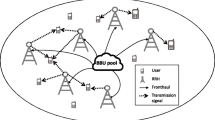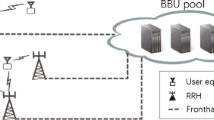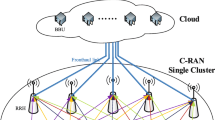Abstract
In this paper, we propose an energy efficient Sparse Beamforming Strategy (SBS) in Cloud Radio Access Networks (C-RAN) to achieve an optimimum energy efficiency. The stochastic geometry method is used to derive some expressions for ergodic rate and coverage probability in downlink transmission. In this system model, Remote Radio Heads (RRHs) are coordinated by a Baseband Unit to transmit data toward users. We assume using RRH clusters where each cluster includes one or two RRHs. To investigate this system, we have used Gauss–Poisson process (GPP). The GPP well describes this clustering scenarios. Considering the intra-cell interference power control, we propose SBS to gain the best performance subject to the energy efficiency (EE) metric. SBS which is based on sparse selections of RRHs, is characterized by introducing analytical expressions and simulation of a C-RAN scenario which the allocation of the RRHs follows the GPP distribution. The numerical results demonstrate that the proposed SBS method improves the overall EE of C-RAN scenario up to 15% with respect to full RRHs coordination, at the high intra-cell interference conditions, and about 30% with respect to no coordination state between RRHs in low intra-cell interference regime.








Similar content being viewed by others
References
Cheng, M., Wang, J. B., Wu, Y., & Lin, M. (2017). Downlink ergodic rate analysis for virtual cell based cloud radio access networks. IEEE Access Journal, 5, 13520–13531.
Wu, J., Zhang, Zh, Hong, Y., et al. (2015). Cloud radio access network (C-RAN): A primer. IEEE Network, 29, 35–41.
Douik, A., Dahrouj, H., Al-Naffouri, T., et al. (2016). Coordinated scheduling and power control in cloud-radio access networks. IEEE Transactions on Wireless Communications, 15, 2523–2536.
Fakhri, Z. H., Khan, M., & Sabir, F., et al. (2017). A resource allocation mechanism for cloud radio access network based on cell differentiation and integration concept. IEEE Transactions on Network Science and Engineering. https://doi.org/10.1109/TNSE.2017.2754101.
Li, Y., Celebi, H., & Daneshmand, M. (2013). Energy efficient femtocell networks: Challenges and opportunities. IEEE Wireless Communications, 20(6), 99–105.
Chih-lin, I., Yuan, Y., Huang, J., et al. (2015). Rethink fronthaul for soft RAN. IEEE Communications Magazine, 53(9), 82–88.
Marsch, P., & Fettweis, G. P. (2011). Coordinated multi-point in mobile communications: From theory to practice. Cambridge: Cambridge University Press.
Tolli, A., Pennanen, H., & Komulainen, P. (2011). Decentralized minimum power multi-cell beam-forming with limited backhaul signaling. IEEE Transactions on Wireless Communications, 10, 570–580.
Li, Y., Liao, C., Wang, Y., & Wang, Ch. (2015). Energy-efficient optimal relay selection in cooperative cellular networks based on double auction. IEEE Transactions on Wireless Communications, 14(8), 4093–4104.
Farahmand, M., & Mohammadi, A. (2017). Sparse power allocation in downlink transmission of cloud radio access networks. IET Communications, 11(16), 2531–2538.
Dai, B., & Yu, W. (2014). Sparse beamforming and user-centric clustering for downlink cloud radio access network. IEEE Access, 2, 1326–1339.
Li, Y., Zhu, X., Liao, Ch., et al. (2015). Energy efficiency maximization by jointly optimizing the positions and serving range of relay stations in cellular networks. IEEE Transactions on Vehicular Technology, 64(6), 2551–2560.
Li, J., Wu, J., Peng, M., et al. (2016). Queue-aware energy-efficient joint remote radio head activation and beamforming in cloud radio access networks. IEEE Transactions on Wireless Communications, 15(6), 3380–3894.
Shi, Y., Zhang, J., & Letaief, Kh B. (2014). Robust group sparse beamforming for multicast green cloud-RAN with imperfect CSI. IEEE Transactions on Wireless Communications, 13(5), 2809–2823.
Hu, B., Hua, C., Zhang, J., et al. (2017). Joint fronthaul multicast beamforming and user-centric clustering in downlink C-RANs. IEEE Transactions on Wireless Communications, 16(8), 5395–5409.
Teng, Y., & Zhao, W. (2017). Robust group sparse beamforming for dense C-RANs with probabilistic SINR constraints. In Wireless communications and networking conference (WCNC), 2017. IEEE, San Francisco, USA, March 2017. https://doi.org/10.1109/WCNC.2017.7925637
Nigam, G., Minero, P., & Haenggi, M. (2014). Coordinated multipoint joint transmission in heterogeneous networks. IEEE Transactions on Communications, 62, 4134–4146.
Wang, H. M., & Zheng, T. X. (2016). Physical layer security in random cellular networks. Berlin: Springer.
Guo, A., Zhong, Y., Zhang, W., et al. (2016). The Gauss–Poisson process for wireless networks and the benefits of cooperation. IEEE Transactions on Communications, 64, 1916–1929.
Tanbourgi, R., Singh, S., Andrews, J., et al. (2014). A tractable model for non-coherent joint-transmission base station cooperation. IEEE Transactions on Wireless Communications, 13, 4959–4973.
Andrews, J. G., Baccelli, F., & Ganti, R. K. (2011). A tractable approach to coverage and rate in cellular networks. IEEE Transactions on Communications, 59, 3122–3134.
Ding, Z., & Poor, H. V. (2013). The use of spatially random base stations in cloud radio access networks. IEEE Signal Processing Letters, 20(11), 1138–1141.
Peng, M., Yan, Sh, & Poor, H. V. (2014). Ergodic capacity analysis of remote radio head associations in cloud radio access networks. IEEE Wireless Communications Letters, 3(4), 365–368.
Wang, H. M., & Zheng, T. X. (2016). Physical layer security in random cellular networks. SpringerBriefs in Computer Science. Springer.
Newman, D. S. (1970). A new family of point processes which are characterized by their second moment properties. Journal of Applied Probability, 7, 338–358.
Haenggi, M. (2012). Stochastic geometry for wireless networks. Cambridge: Cambridge University Press.
Bartelt, J., Rost, P., Wubben, D., et al. (2015). Fronthaul and backhaul requirements of flexibly centralized radio access networks. IEEE Wireless Communications, 22, 105–111.
Hajisami, A., & Pompili, D. (2015). Cloud-CFFR: Coordinated fractional frequency reuse in cloud radio access network (C-RAN). In 2015 IEEE 12th international conference on mobile ad hoc and sensor systems (pp. 46–54).
Björnson, E., Sanguinetti, L., Hoydis, J., et al. (2015). Optimal design of energy-efficient multi-user MIMO systems: Is massive MIMO the answer? IEEE Transactions on Wireless Communications, 14, 3059–3075.
Sabella, D., De Domenico, A., Katranaras, E., et al. (2014). Energy efficiency benefits of RAN-as-a-service concept for a cloud-based 5G mobile network infrastructure. IEEE Access, 2, 1586–1597.
Peng, M., Yu, Y., Xiang, H., & Poor, H. V. (2015). Energy-efficient resource allocation optimization for multimedia heterogeneous cloud radio access networks. IEEE Transactions on Vehicular Technology, 64, 5275–5278.
Qin, C., Ni, W., Tian, H., & Liu, R. P. (2017). Fronthaul load balancing in energy harvesting powered cloud radio access networks. IEEE Access, 5, 7762–7775.
Amjad, M., Akhtar, F., Rehmani, M. H., et al. (2017). Full-duplex communication in cognitive radio networks: A survey. IEEE Communiications Surveys and Tutorials, 19(4), 2158–2191.
Li, Y., Liu., J., Cao, B., & Wang, C. (2018). Joint optimization of radio and virtual machine resources with uncertain user demands in mobile cloud computing. IEEE Transactions on Multimedia. https://doi.org/10.1109/TMM.2018.2796246.
Author information
Authors and Affiliations
Corresponding author
Appendix: A detailed proof of (12) and (13)
Appendix: A detailed proof of (12) and (13)
The left side of (12) is expanded to
where (a) is from considering high SIR in the C-RAN, and T is expressed as
where (b) results from exponential distribution of h, i.e. \(h \sim \exp (1)\). (27) can be continued as
where (c) is because of i.i.d distribution of h and its independency from \({\varPhi }\). (d) is PGFL of \({\varPhi }\) [24]. Moreover, \(W_1(x)\) and \(W_2(x)\) can be described as
after some manipulation, \(W_1(x)\) and \(W_2(x)\) can be calculated as follow
where \(K=P_2/P_1\). Therefore, the proof is completed.
Rights and permissions
About this article
Cite this article
Farahmand, M., Mohammadi, A. Characterization of sparse beamforming for energy efficiency in cloud radio access networks using Gauss–Poisson process. Wireless Netw 25, 4555–4567 (2019). https://doi.org/10.1007/s11276-018-1752-x
Published:
Issue Date:
DOI: https://doi.org/10.1007/s11276-018-1752-x




